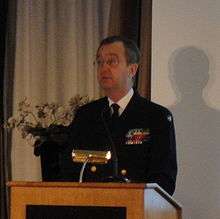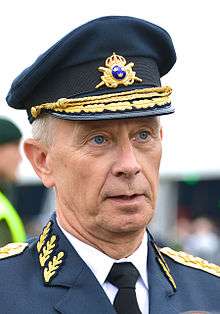Supreme Commander of the Swedish Armed Forces
| Supreme Commander of the Swedish Armed Forces
Överbefälhavaren | |
|---|---|
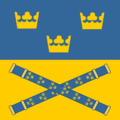 Command flag of the Supreme Commander | |
| Swedish Armed Forces | |
| Reports to |
The Government (in practice through the Minister for Defence) |
| Residence | Karlberg Palace |
| Seat | Lidingövägen 24, Stockholm, Sweden |
| Nominator | Minister for Defence |
| Appointer | The Government |
| Constituting instrument |
Förordning (2007:1266) med instruktion för Försvarsmakten (current ordinance) |
| Precursor | None [lower-alpha 1] |
| Formation | 8 December 1939 |
| First holder | Olof Thörnell |
| Deputy | The Director-General |
| Website | Official website |
The Supreme Commander (Swedish: Överbefälhavaren; acronym: ÖB) is the highest ranked professional military officer in the Swedish Armed Forces, and is by NATO terminology the Swedish chief of defence equivalent. The Supreme Commander is the agency head of the Swedish Armed Forces and formally reports to the Government of Sweden, though normally through the Minister for Defence.[2][lower-alpha 2] The primary responsibilities and duties of the Supreme Commander (and the charter for the Armed Forces) are prescribed in an ordinance issued by the Government.[3]
The Supreme Commander is, apart from the honorary ranks held by the King of Sweden and in the past other members of the Swedish Royal Family, by unwritten convention normally the only professional military officer on active duty to hold the highest rank (a four-star General or Admiral).[4] An exception was made 2009-2014 when Håkan Syrén was chairman of the European Union Military Committee.
The present Supreme Commander, General Micael Bydén, took office on 1 October 2015.[1]
Historical background
Before the modern era, the King was expected to command the forces himself; not seldom on location during war campaigns as shown by Gustavus Adolphus, Charles X, Charles XI and Charles XII. This remained the case formally until the 20th century. From the late 19th century onwards, there were no service chiefs of the Army or Navy; all senior service commanders reported directly to the King in Council. Apart from a single Minister for Defence created in 1919 by merging the position of ministers of the land forces and naval forces, no joint command structure existed.[4]
In 1936, a Supreme Commander was intended to be appointed in war-time-only, and on 1 December 1939, during World War II, the first Supreme Commander, General Olof Thörnell, was appointed.[4] In 1942 it was decided to keep this office even after the end of the war. The Supreme Commander would in wartime formally report to the King in Council until the enactment of the new Instrument of Government in 1974, and after 1 January 1975 to the Government.[4]
Heraldry
The command flag of the Supreme Commander is drawn by Brita Grep and embroidered by hand by the Kedja studio, Heraldica. Blazon: "Fessed in blue and yellow; on blue three open yellow crowns placed two and one, on yellow two blue batons of command with sets of open yellow crowns placed two and one in saltire."[5]
List of Officeholders
| № | Name | Took office | Left office | Time in office | Defence branch | Ref | |
|---|---|---|---|---|---|---|---|
| 1 | General Olof Thörnell (1877–1977) | 8 December 1939 | 31 March 1944 | 4 years, 114 days | 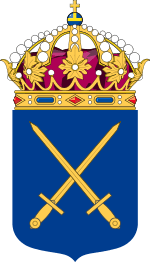 Army | [4] | |
| 2 | General Helge Jung (1886–1978) | 1 April 1944 | 31 March 1951 | 6 years, 364 days |  Army | [4] | |
| 3 | General Nils Swedlund (1898–1965) | 1 April 1951 | 30 September 1961 | 10 years, 182 days |  Army | [4] | |
| 4 | General Torsten Rapp (1905–1993) | 1 October 1961 | 30 September 1970 | 8 years, 364 days | 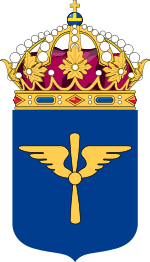 Air Force | [4] | |
| 5 | General Stig Synnergren (1915–2004) | 1 October 1970 | 30 September 1978 | 7 years, 364 days |  Army | [4] | |
| 6 | General Lennart Ljung (1921–1990) | 1 October 1978 | 30 September 1986 | 7 years, 364 days |  Army | [4] | |
| 7 | General Bengt Gustafsson (born 1933) | 1 October 1986 | 30 June 1994 | 7 years, 272 days |  Army | [4] | |
| 8 | General Owe Wiktorin (born 1940) | 1 July 1994 | 30 June 2000 | 5 years, 365 days |  Air Force | [4][6] | |
| 9 | General Johan Hederstedt (born 1943) | 1 July 2000 | 31 December 2003 | 3 years, 184 days |  Army | [4][7] | |
| 10 | General Håkan Syrén (born 1952) | 1 January 2004 | 24 March 2009 | 5 years, 82 days | 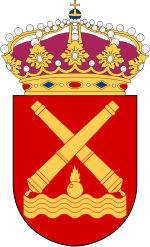 Navy (Amphibious Corps) | [4] | |
| 11 | General Sverker Göranson (born 1954) | 25 March 2009 | 1 October 2015 | 6 years, 189 days |  Army | [8] | |
| 12 | General Micael Bydén (born 1964) | 1 October 2015 | Incumbent | 3 years, 21 days |  Air Force | [9] |
Timeline

Every time a new Supreme Commander is to be appointed, there is some debate between the different services. Some feel that some kind of rotational system would be appropriate. In actuality, most Supreme Commanders have come from the Army, and only one, Håkan Syrén, from the Navy. Because he is a General of the Amphibious Corps, there has to this day not been a single Admiral to hold the office.
See also
- Lord High Admiral of Sweden (historical antecedent)
- Lord High Constable of Sweden (historical antecedent)
Notes
- ↑ there was no single career officer in charge of the all the forces before the creation of this position (all senior service commanders reported directly to the King and his Council).
- ↑ Although the Minister for Defence heads the Ministry of Defence, the Minister cannot as a general rule issue directives in his/her own right to the Supreme Commander or any other agency director-general in the defence portfolio due to the Swedish prohibition on ministerial rule, unless such authority is provided for in specific statutory provisions.
References
- 1 2 "Överbefälhavaren" (in Swedish). Swedish Armed Forces. Retrieved 2015-10-01.
- ↑ "Supreme Commander". Swedish Armed Forces. Archived from the original on 2014-10-24. Retrieved 2014-10-24.
- ↑ "Förordning (2007:1266) med instruktion för Försvarsmakten" (in Swedish). Swedish Code of Statutes. Retrieved 2014-10-24.
- 1 2 3 4 5 6 7 8 9 10 11 12 13 14 "ÖB i historien" (in Swedish). Swedish Armed Forces. Retrieved 2014-10-24.
- ↑ Braunstein, Christian (2004). Svenska försvarsmaktens fälttecken efter millennieskiftet [The flags and standards of the Swedish armed forces after the turn of the millennium] (PDF). Skrift / Statens försvarshistoriska museer, 1101-7023 ; 7 [dvs 8] (in Swedish). Stockholm: Statens försvarshistoriska museer. p. 105. ISBN 91-971584-7-X. LIBRIS 9815350.
- ↑ Mortensen, Per (2000-05-06). "DN gratulerar: Stridspilot blir landsvägsriddare". Dagens Nyheter (in Swedish). Retrieved 28 April 2017.
- ↑ "Johan Hederstedt avgår som ÖB vid årsskiftet". Expressen (in Swedish). TT. 4 November 2003. Retrieved 28 April 2017.
- ↑ "Sverker Göranson blir ny överbefälhavare" [Sverker Göranson becomes new Supreme Commander] (Press release) (in Swedish). Government Offices of Sweden. Ministry of Defence. 6 March 2009. p. 615. Retrieved 2017-04-26.
- ↑ "Micael Bydén ny ÖB" (in Swedish). Swedish Armed Forces. Retrieved 2015-09-11.
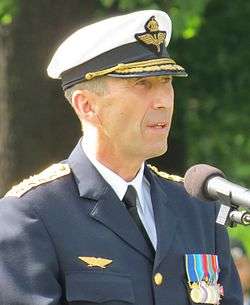

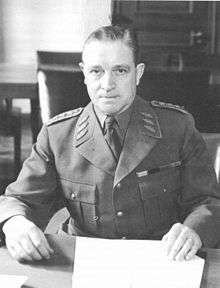
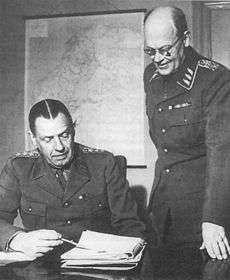
.jpg)
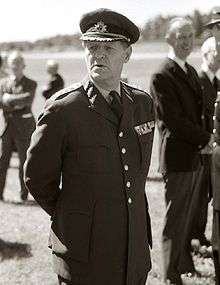
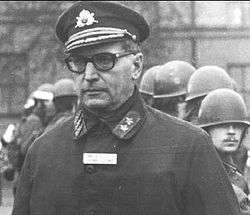
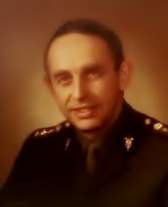
.jpg)
